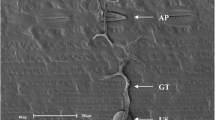Abstract
The effects of plant development and leaf age on the infection efficiency (IE), the latency period (LP) and the sporulation intensity (SP) of groundnut rust were studied using detached and attached leaflets of a highly susceptible groundnut cultivar. The results indicate a decrease ofIE with increasing leaf age and an increase ofLP with increasing leaf age and development stage. A significant effect of detachment onIE was found. However, experiments on both detached and non-detached leaflets resulted in the same, general conclusions. The observed reduction ofIE and lengthening ofLP suggest that further studies would profitably distinguish epidemiologically different layers in the host canopy.
Samenvatting
De invloed van het ontwikkelingsstadium van de plant en van de leeftijd van het blad op de infectie-efficiëntie (IE), de latentieperiode (LP) en de sporulatie-intensiteit (SP) van aardnootroest werd onderzocht bij een zeer vatbare aardnoot-cultivar aan wel en niet afgesneden deelblaadjes. De resultaten laten een afname zien vanIE bij toenemende bladleeftijd alsmede een toename vanLP met de toename van bladleeftijd en ontwikkelingsstadium. Het effect van het afsnijden van de deelblaadjes opIE was significant, maar proeven met wel en met niet afgesneden blaadjes leidden tot dezelfde algemene gevolgtrekkingen. De waargenomen afname vanIE en verlenging vanLP doen vermoeden dat voortgezet onderzoek een nuttig onderscheid zal kunnen maken tussen in epidemiologische zin verschillende bladlagen van het gewas.
Similar content being viewed by others
References
Aust, H.J., Bashi, E. & Rotem, J., 1980. Flexibility of plant pathogens in exploiting ecological and biotic conditions in the development of epidemics. In: Palti, J. & Kranz, J. (Eds), Comparative epidemiology. A tool for better disease management. Pudoc, Wageningen, p. 46–56.
Boote, K.J., 1982. Growth stages of peanut (Arachis hypogaea L.). Peanut Science 9: 35–40.
Cook, M., 1980a. Host-parasite relations in uredial infections of peanut byPuccinia arachidis. Phytopathology 70: 822–826.
Cook, M., 1980b. Peanut leaf wettability and susceptibility to infection byPuccinia arachidis. Phytopathology 70: 826–830.
Ohm, H.W. & Shaner, E., 1976. Three components of slow leaf rusting at different growth stages in wheat. Phytopathology 66: 1356–1360.
Parlevliet, J.E., 1975. Partial resistance of barley to leafrust,Puccinia hordei. I. Effects of cultivar and development stage on latent period. Euphytica 24: 21–27.
Parlevliet, J.E. & Kuiper, H.J., 1977. Partial resistance of barley to leafrust,Puccinia hordei. IV. Effects of cultivar and development stage on infection frequency. Euphytica 26: 249–255.
Populer, C., 1978. Changes in host susceptibility with time. In: Horsfall, J.G. & Cowling, E.B. (Eds), Plant disease. An advanced treatise, Vol. III. Academic Press, New York, p. 239–262.
Savary, S., 1985a. Comparaison de différentes techniques d'infection de folioles d'arachide parPuccinia arachidis Speg. Agronomie 5: 325–329.
Savary, S., 1985b. Effets du niveau de contamination et de la température sur quelques étapes du cycle dePuccinia arachides Speg. Agronomie 5: 479–485.
Schein, R.D., 1964. Design, performance, and use of a quantitative inoculator. Phytopathology 54: 509–513.
Schein, R.D., 1965. Age-correlated changes in susceptibility of bean leaves toUromyces phaseoli and tobacco mosaic virus. Phytopathology 55: 454–457.
Simkin, M.B. & Wheeler, B.E.J., 1974. The development ofPuccinia hordei on barley cv. Zephyr. Annals of Applied Biology 78: 225–235.
Tomerlin, J.R., Eversmeyer, M.G., Kramer, C.L. & Browder, L.E., 1983. Temperature and host effects on latent and infectious periods and on urediniospore production ofPuccinia recondita f.sp.tritici. Phytopathology 73: 414–419.
Van der Plank, J.E., 1963. Plant diseases Epidemics and control. Academic Press. New York, London, 349 pp.
Vanderplank, J.E., 1982. Host-pathogen interactions in plant disease. Academic Press, New York, 207 pp.
Zadoks, J.C., 1967. An inhibitory effect of light on the infection by brown leaf rust on wheat. Netherlands Journal of Plant Pathology 73: 52–54.
Zadoks, J.C., 1972. Modern concepts in disease resistance in cereals. In: Lupton, F.A.G.H., Jenkins, G. & Johnson, R. (Eds), The way ahead in plant breeding. Eucarpia, Cambridge, p. 89–98.
Zadoks, J.C. & Schein, R.D., 1979. Epidemiology and plant disease management. Oxford University Press, New York, Oxford, 427 pp.
Author information
Authors and Affiliations
Rights and permissions
About this article
Cite this article
Savary, S. Decrease by plant development and leaf age of susceptibility of groundnut to rust (Puccinia arachidis) in a susceptible cultivar. Netherlands Journal of Plant Pathology 93, 25–31 (1987). https://doi.org/10.1007/BF01998141
Accepted:
Issue Date:
DOI: https://doi.org/10.1007/BF01998141




